 | ||
Arts and crafts movement
The Arts and Crafts movement was an international movement in the decorative and fine arts that began in Britain and flourished in Europe and North America between 1880 and 1910, emerging in Japan in the 1920s. It stood for traditional craftsmanship using simple forms, and often used medieval, romantic, or folk styles of decoration. It advocated economic and social reform and was essentially anti-industrial. It had a strong influence on the arts in Europe until it was displaced by Modernism in the 1930s, and its influence continued among craft makers, designers, and town planners long afterwards.
Contents
- Arts and crafts movement
- Social and design principles
- A W N Pugin
- John Ruskin
- William Morris
- Development
- Later influences
- Ireland
- Scotland
- Continental Europe
- North America
- Architecture and Art
- Museums
- Asia
- Architecture
- Architectural examples
- Garden design
- Art education
- References
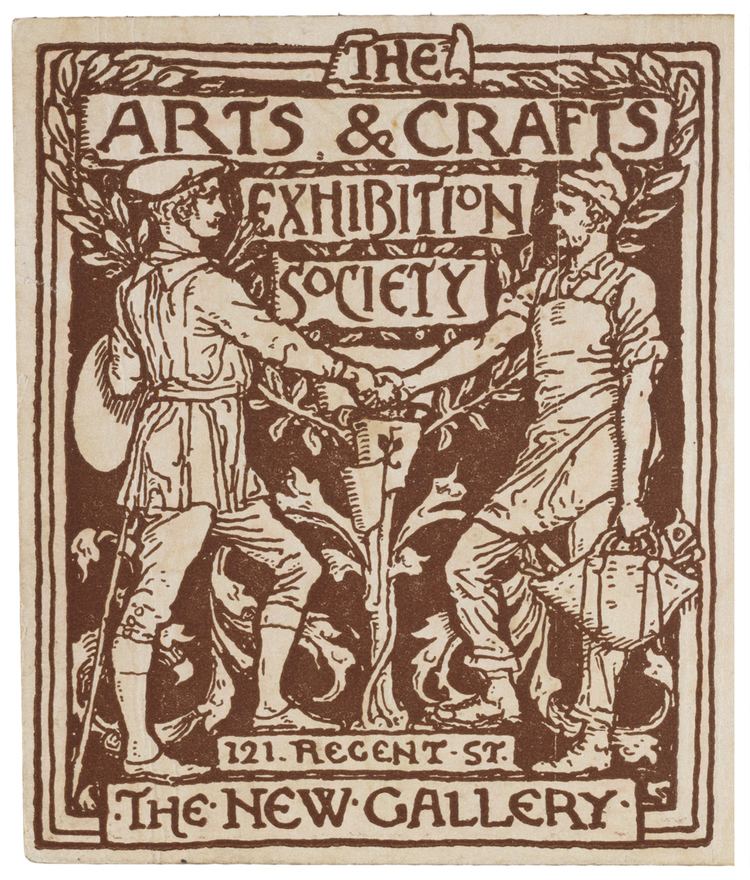
The term was first used by T. J. Cobden-Sanderson at a meeting of the Arts and Crafts Exhibition Society in 1887, although the principles and style on which it was based had been developing in England for at least twenty years. It was inspired by the ideas of architect Augustus Pugin (1812–1852), writer John Ruskin (1819–1900), and designer William Morris (1834–1896).
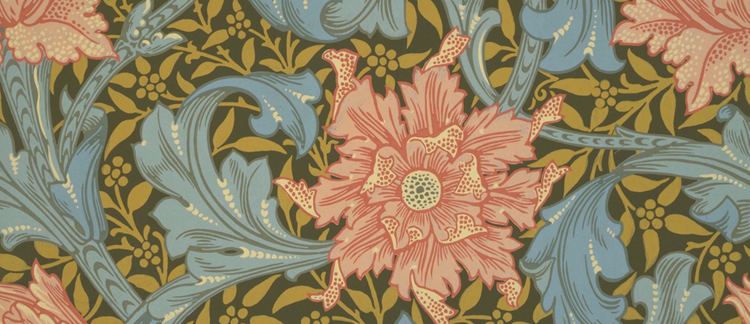
The movement developed earliest and most fully in the British Isles, and spread across the British Empire and to the rest of Europe and North America. It was largely a reaction against the perceived impoverished state of the decorative arts at the time and the conditions in which they were produced.
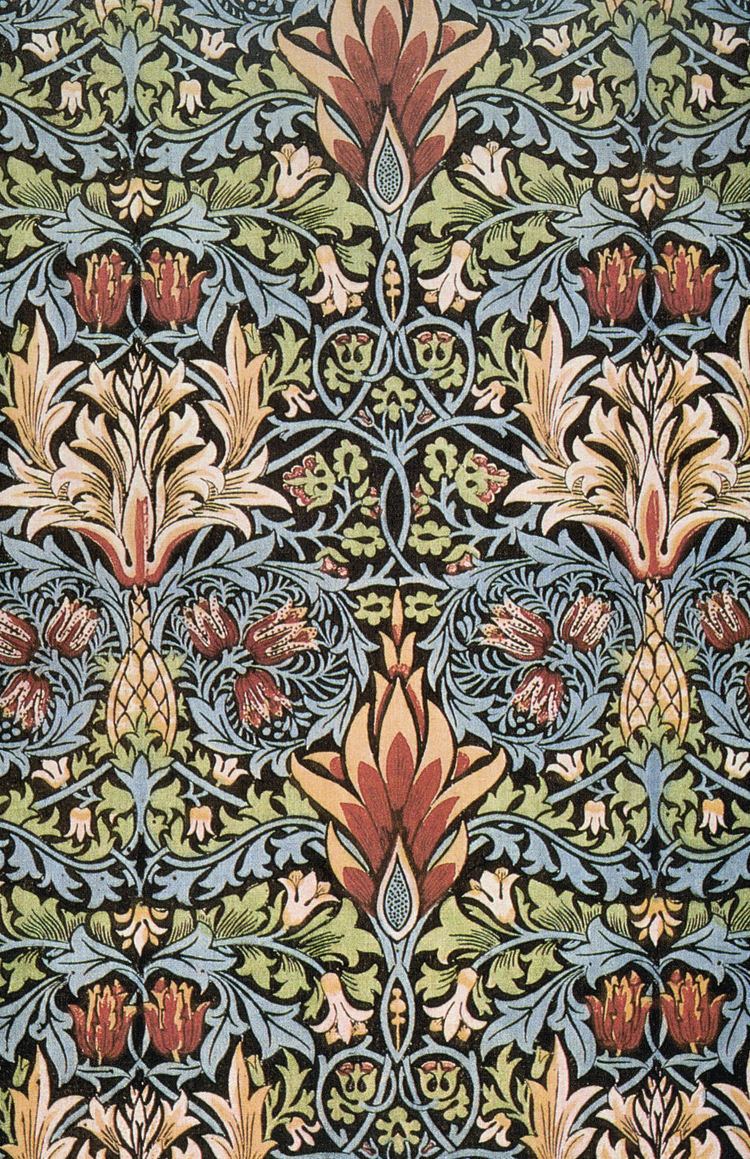
Arts and crafts movement
Social and design principles
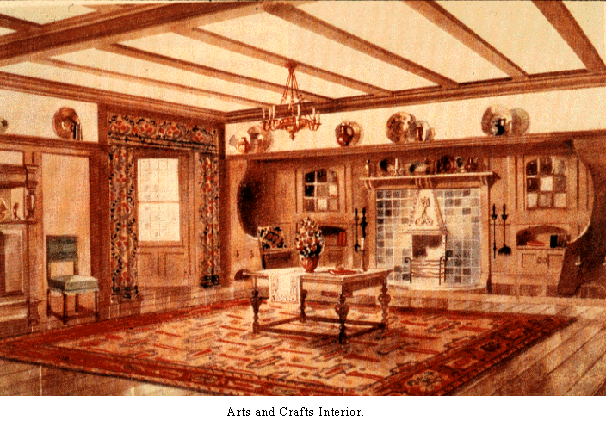
The Arts and Crafts style emerged from the attempt to reform design and decoration in mid 19th century Britain. It was a reaction against a decline in standards that the reformers associated with machinery and factory production, and was in part a response to items shown in the Great Exhibition of 1851 that were ornate, artificial and ignored the qualities of the materials used. But it was as much a movement of social reform as design reform and its leading practitioners did not separate the two.
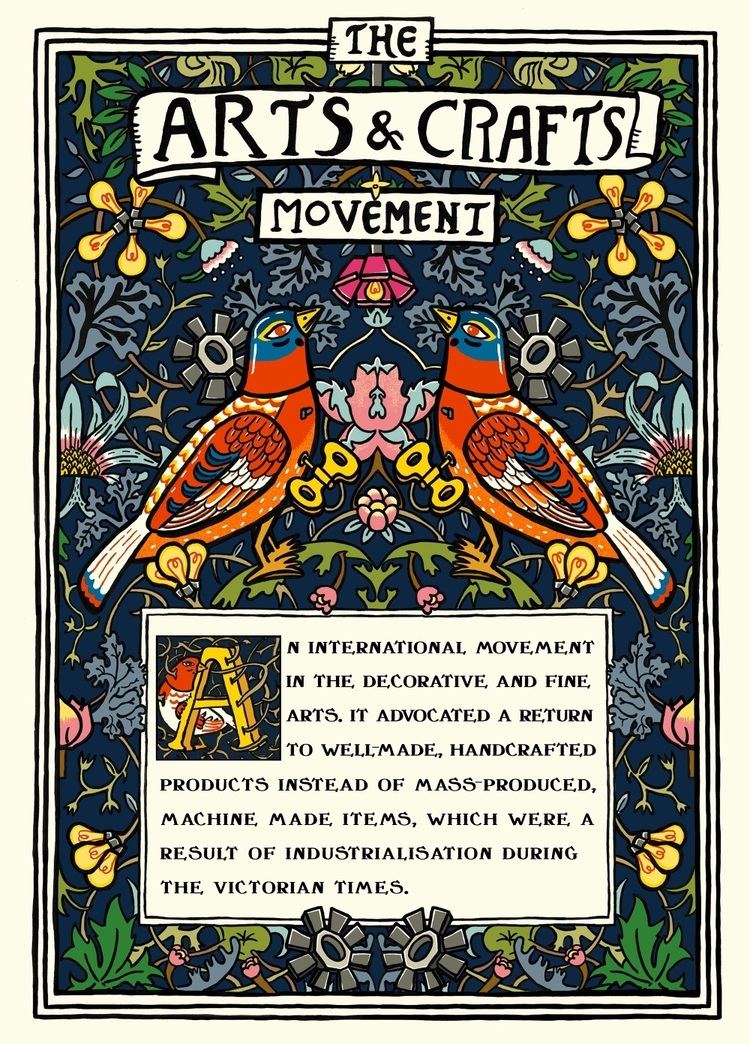
The art historian Nikolaus Pevsner has said that exhibits in the Great Exhibition showed "ignorance of that basic need in creating patterns, the integrity of the surface" and "vulgarity in detail". Design reform began with the organisers of the Exhibition itself, Henry Cole (1808–1882), Owen Jones (1809–1874), Matthew Digby Wyatt (1820–1877) and Richard Redgrave (1804–1888), and the dislike of excessive ornament and badly made things was not exclusive to the Arts and Crafts movement. Owen Jones, for example, declared that "Ornament ... must be secondary to the thing decorated", that there must be "fitness in the ornament to the thing ornamented", and that wallpapers and carpets must not have any patterns "suggestive of anything but a level or plain". Where a fabric or wallpaper in the Great Exhibition might be decorated with a natural motif made to look as real as possible, an Arts and Crafts, like the Artichoke design illustrated above, would use a flat and simplified natural motif.
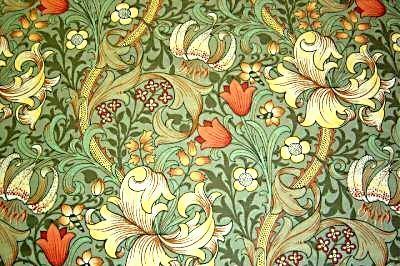
William Morris, a major figure in 19th century design reform, whose ideas inspired the Arts and Crafts Movement, advocated production by traditional craft methods but was inconsistent in his view of what place machinery should play. At one point he said that production by machinery was "altogether an evil", but he was willing to use manufacturers able to work to his standards with the aid of machinery; and he said that, in a "true society", where neither luxuries nor cheap trash were made, machinery could be improved and used to reduce the hours of labour. Fiona MacCarthy says that "unlike later zealots like Gandhi, William Morris had no practical objections to the use of machinery per se so long as the machines produced the quality he needed." Morris's followers also had subtly differing views or changed their minds over time. C.R.Ashbee, for example, a central figure in the Arts and Crafts Movement, shared Morris's ambivalence. At the time of his Guild of Handicraft, initiated in 1888, he said, "We do not reject the machine, we welcome it. But we would desire to see it mastered." After unsuccessfully pitting his Guild and School of Handicraft guild against modern methods of manufacture, he acknowledged that "Modern civilization rests on machinery", but he continued to criticize the deleterious effects of what he called "mechanism", saying that "the production of certain mechanical commodities is as bad for the national health as is the production of slave-grown cane or child-sweated wares."
Morris insisted that the artist should be a craftsman-designer working by hand and advocated a society of free craftspeople, which he believed had existed during the Middle Ages. "Because craftsmen took pleasure in their work", he wrote, "the Middle Ages was a period of greatness in the art of the common people. ... The treasures in our museums now are only the common utensils used in households of that age, when hundreds of medieval churches - each one a masterpiece - were built by unsophisticated peasants." Medieval art was the model for much Arts and Crafts design and medieval life, before capitalism and the factory system, was idealised by the movement.
Morris and his followers believed the division of labour on which modern industry depended was undesirable, but not all Arts and Crafts artists carried out every stage in the making of goods themselves, and it was only in the twentieth century that that became an essential part of the definition of craftsmanship. The founders of the Arts and Crafts Exhibition Society did not insist that the designer should also be the maker. Peter Floud, writing in the 1950s, said that "The founders of the Society ... never executed their own designs, but invariably turned them over to commercial firms." The idea that the designer should be the maker and the maker the designer derived "not from Morris or early Arts and Crafts teaching, but rather from the second-generation elaboration doctrine worked out in the first decade of [the twentieth] century by men such as W. R. Lethaby".
The Arts and Crafts Movement was associated with socialist ideas in the persons of Morris, T. J. Cobden Sanderson, Walter Crane, Ashbee and others. In the early 1880s Morris was spending more of his time on socialist propaganda than on designing and making. Ashbee established a community of craftsmen, the Guild of Handicraft, in east London, later moving to Chipping Campden. Those adherents who were not socialists, for example, Alfred Hoare Powell, advocated a more humane and personal relationship between employer and employee. Lewis Foreman Day, a very successful and influential Arts and Crafts designer, was not a socialist either, despite his long friendship with Crane.
In Britain the movement was associated with dress reform, ruralism, the garden city movement and the folk-song revival, and in continental Europe with the preservation of national traditions in building, the applied arts, domestic design and costume.
A. W. N. Pugin
Some of the ideas of the movement were anticipated by A.W.N. Pugin (1812–1852), a leader in the Gothic revival in architecture. For example, he, like the Arts and Crafts artists, advocated truth to material, structure and function. Pugin articulated the tendency of social critics to compare the faults of modern society (such as the sprawling growth of cities and the treatment of the poor) unfavorably with the Middle Ages, a tendency that became routine with Ruskin, Morris and the Arts and Crafts movement. His book Contrasts (1836) drew examples of bad modern buildings and town planning in contrast with good medieval examples, and his biographer Rosemary Hill notes that in it he "reached conclusions, almost in passing, about the importance of craftsmaship and tradition in architecture that it would take the rest of the century and the combined efforts of Ruskin and Morris to work out in detail." She describes the spare furnishings he specified for a building in 1841 - "rush chairs, oak tables" - as "the Arts and Crafts interior in embryo."
John Ruskin
The Arts and Crafts philosophy derived in large measure from Ruskin's social criticism, which related the moral and social health of a nation to the qualities of its architecture and to the nature of work. Ruskin considered the sort of mechanized production and division of labour that had been created in the industrial revolution to be "servile labour" and he thought that a healthy and moral society required independent workers who designed the things they made. His followers favoured craft production over industrial manufacture and were concerned about the loss of traditional skills, but they were arguably more troubled by effects of the factory system than by machinery itself and William Morris's idea of "handicraft" was essentially work without any division of labour rather than work without any sort of machinery.
William Morris
Morris, the towering figure in late 19th century design, was the main influence on the Arts and Crafts movement. The aesthetic and social vision of the Arts and Crafts movement derived from ideas he developed in the 1850s with a group of students at the University of Oxford, who combined a love of Romantic literature with a commitment to social reform. By 1855 they had discovered Ruskin and, believing there to be a contrast between the barbarity of contemporary art and the painters preceding Raphael (1483-1530), they formed themselves into the Pre-Raphaelite Brotherhood to pursue their artistic aims. The medievalism of Mallory's Morte d'Arthur set the standard for their early style. In Edward Burne-Jones' words, they intended to "wage Holy warfare against the age".
Morris began experimenting with various crafts and designing furniture and interiors. He was personally involved in manufacture as well as design, which was to be the hallmark of the Arts and Crafts movement. Ruskin had argued that the separation of the intellectual act of design from the manual act of physical creation was both socially and aesthetically damaging; Morris further developed this idea, insisting that no work should be carried out in his workshops before he had personally mastered the appropriate techniques and materials, arguing that "without dignified, creative human occupation people became disconnected from life".
In 1861 Morris began making furniture and decorative objects commercially, modeling his designs on medieval styles and using bold forms and strong colors. His patterns were based on flora and fauna and his products were inspired by the vernacular or domestic traditions of the British countryside. In order to display the beauty of the materials and the work of the craftsman, some were deliberately left unfinished, creating a rustic appearance. Truth to materials, structure and function became characteristic of the Arts and Crafts movement.
Development
Morris's designs quickly became popular, attracting interest when his company's work was exhibited at the 1862 International Exhibition. Much of Morris & Co's early work was for churches and Morris won important interior design commissions at St James's Palace and the South Kensington Museum (now the Victoria and Albert Museum). Later his work became popular with the middle and upper classes, despite his wish to create a democratic art, and by the end of the 19th century, Arts and Crafts design in houses and domestic interiors was the dominant style in Britain, copied in products made by conventional industrial methods.
The spread of Arts and Crafts ideas during the late 19th and early 20th centuries resulted in the establishment of many associations and craft communities, although Morris was not involved with them because of his preoccupation with socialism in the 1880s. A hundred and thirty Arts and Crafts organisations were formed in Britain, most between 1895 and 1905.
In 1881, Eglantyne Louisa Jebb, Mary Fraser Tytler and others initiated the Home Arts and Industries Association to encourage the working classes, especially those in rural areas, to take up handicrafts under supervision, not for profit, but in order to provide them with useful occupations and to improve their taste. By 1889 it had 450 classes, 1,000 teachers and 5,000 students.
In 1882, architect A.H.Mackmurdo formed the Century Guild, a partnership of designers including Selwyn Image, Herbert Horne, Clement Heaton and Benjamin Creswick.
In 1884, the Art Workers Guild was initiated by five young architects, William Lethaby, Edward Prior, Ernest Newton, Mervyn Macartney and Gerald C. Horsley, with the goal of bringing together fine and applied arts and raising the status of the latter. It was directed originally by George Blackall Simonds. By 1890 the Guild had 150 members, representing the increasing number of practitioners of the Arts and Crafts style. It still exists.
The London department store Liberty & Co., founded in 1875, was a prominent retailer of goods in the style and of the "artistic dress" favoured by followers of the Arts and Crafts movement.
In 1887 the Arts and Crafts Exhibition Society, which gave its name to the movement, was formed with Walter Crane as president, holding its first exhibition in the New Gallery, London, in November 1888. It was the first show of contemporary decorative arts in London since the Grosvenor Gallery's Winter Exhibition of 1881. Morris & Co. was well represented in the exhibition with furniture, fabrics, carpets and embroideries. Edward Burne-Jones observed, "here for the first time one can measure a bit the change that has happened in the last twenty years". The society still exists as the Society of Designer Craftsmen.
In 1888, C.R.Ashbee, a major late practitioner of the style in England, founded the Guild and School of Handicraft in the East End of London. The guild was a craft co-operative modelled on the medieval guilds and intended to give working men satisfaction in their craftsmanship. Skilled craftsmen, working on the principles of Ruskin and Morris, were to produce hand-crafted goods and manage a school for apprentices. The idea was greeted with enthusiasm by almost everyone except Morris, who was by now involved with promoting socialism and thought Ashbee's scheme trivial. From 1888 to 1902 the guild prospered, employing about 50 men. In 1902 Ashbee relocated the guild out of London to begin an experimental community in Chipping Campden in the Cotswolds. The guild's work is characterized by plain surfaces of hammered silver, flowing wirework and colored stones in simple settings. Ashbee designed jewellery and silver tableware. The guild flourished at Chipping Camden but did not prosper and was liquidated in 1908. Some craftsmen stayed, contributing to the tradition of modern craftsmanship in the area.
Charles Francis Annesley Voysey (1857–1941) was an Arts and Crafts architect who also designed fabrics, tiles, ceramics, furniture and metalwork. His style combined simplicity with sophistication. His wallpapers and textiles, featuring stylised bird and plant forms in bold outlines with flat colors, were used widely.
Morris's thought influenced the distributism of G. K. Chesterton and Hilaire Belloc.
By the end of the nineteenth century, Arts and Crafts ideals had influenced architecture, painting, sculpture, graphics, illustration, book making and photography, domestic design and the decorative arts, including furniture and woodwork, stained glass, leatherwork, lacemaking, embroidery, rug making and weaving, jewelry and metalwork, enameling and ceramics. By 1910, there was a fashion for "Arts and Crafts" and all things hand-made and a proliferation of amateur handicrafts of variable quality.
Later influences
The British artist potter Bernard Leach brought to England many ideas he had developed in Japan with the social critic Yanagi Soetsu about the moral and social value of simple crafts; both were enthusiastic readers of Ruskin. Leach was an active propagandist for these ideas, which struck a chord with practitioners of the crafts in the inter-war years, and he expounded them in his book The Art of the Potter, published in 1940, which denounced industrial society in terms as vehement as those of Ruskin and Morris. Thus the Arts and Crafts philosophy was perpetuated among British craft workers in the 1950s and 1960s, long after the demise of the Arts and Crafts movement and at the high tide of Modernism. British Utility furniture of the 1940s also derived from Arts and Crafts principles. One of its main promoters, Gordon Russell, chairman of the Utility Furniture Design Panel, was imbued with Arts and Crafts ideas. He manufactured furniture in the Cotswold Hills, a region of Arts and Crafts furniture-making since Ashbee, and he was a member of the Arts and Crafts Exhibition Society. William Morris's biographer, Fiona MacCarthy, detected the Arts and Crafts philosophy even behind the Festival of Britain (1951), the work of the designer Terence Conran (b. 1931) and the founding of the British Crafts Council in the 1970s.
Ireland
The movement spread to Ireland, representing an important time for the nation's cultural development, a visual counterpart to the literary revival of the same time and was a publication of Irish nationalism. The Arts and Crafts use of stained glass was popular in Ireland, with Harry Clarke the best-known artist and also with Evie Hone. The architecture of the style is represented by the Honan Chapel (1916) in Cork in the grounds of University College Cork. Other architects practicing in Ireland included Sir Edwin Lutyens (Heywood House in Co. Laois, Lambay Island and the Irish National War Memorial Gardens in Dublin) and Frederick 'Pa' Hicks (Malahide Castle estate buildings and round tower). Irish Celtic motifs were popular with the movement in silvercraft, carpet design, book illustrations and hand-carved furniture.
Scotland
The beginnings of the Arts and Crafts movement in Scotland were in the stained glass revival of the 1850s, pioneered by James Ballantine (1808–77). His major works included the great west window of Dunfermline Abbey and the scheme for St. Giles Cathedral, Edinburgh. In Glasgow it was pioneered by Daniel Cottier (1838–91), who had probably studied with Ballantine, and was directly influenced by William Morris, Ford Madox Brown and John Ruskin. His key works included the Baptism of Christ in Paisley Abbey, (c. 1880). His followers included Stephen Adam and his son of the same name. The Glasgow-born designer and theorist Christopher Dresser (1834–1904) was one of the first, and most important, independent designers, a pivotal figure in the Aesthetic Movement and a major contributor to the allied Anglo-Japanese movement. The movement had an "extraordinary flowering" in Scotland where it was represented by the development of the 'Glasgow Style' which was based on the talent of the Glasgow School of Art. Celtic revival took hold here, and motifs such as the Glasgow rose became popularised. Charles Rennie Mackintosh and the Glasgow School of Art were to influence others worldwide.
Continental Europe
In continental Europe, the revival and preservation of national styles was an important motive of Arts and Crafts designers; for example, in Germany, after unification in 1871 under the encouragement of the Bund für Heimatschutz (1897) and the Vereinigte Werkstätten für Kunst im Handwerk founded in 1898 by Karl Schmidt; and in Hungary Károly Kós revived the vernacular style of Transylvanian building. In central Europe, where several diverse nationalities lived under powerful empires (Germany, Austria-Hungary and Russia), the discovery of the vernacular was associated with the assertion of national pride and the striving for independence, and, whereas for Arts and Crafts practitioners in Britain the ideal style was to be found in the medieval, in central Europe it was sought in remote peasant villages.
Widely exhibited in Europe, the Arts and Crafts style's simplicity inspired designers like Henry van de Velde and styles such as Art Nouveau, the Dutch De Stijl group, Vienna Secession, and eventually the Bauhaus style. Pevsner regarded the style as a prelude to Modernism, which used simple forms without ornamentation.
The earliest Arts and Crafts activity in continental Europe was in Belgium in about 1890, where the English style inspired artists and architects including can de Velde, Gabriel Van Dievoet, Gustave Serrurier-Bovy and a group known as La Libre Esthétique (Free Aesthetic).
Arts and Crafts products were admired in Austria and Germany in the early 20th century, and under their inspiration design moved rapidly forward while it stagnated in Britain. The Wiener Werkstätte, founded in 1903 by Josef Hoffmann and Koloman Moser, was influenced by the Arts and Crafts principles of the "unity of the arts" and the hand-made. The Deutscher Werkbund (German Association of Craftsmen) was formed in 1907 as an association of artists, architects, designers, and industrialists to improve the global competitiveness of German businesses and became an important element in the development of modern architecture and industrial design through its advocacy of standardized production. However, its leading members, van de Velde and Hermann Muthesius, had conflicting opinions about standardization. Muthesius believed that it was essential were Germany to become a leading nation in trade and culture. Van de Velde, representing a more traditional Arts and Crafts attitude, believed that artists would forever "protest against the imposition of orders or standardization," and that "The artist ... will never, of his own accord, submit to a discipline which imposes on him a canon or a type."
In Finland, an idealistic artists' colony in Helsinki was designed by Herman Gesellius, Armas Lindgren and Eliel Saarinen, who worked in the National Romantic style, akin to the British Gothic Revival.
In Hungary, under the influence of Ruskin and Morris, a group of artists and architects, including Károly Kós, Aladár Körösfői-Kriesch and Ede Toroczkai Wigand, discovered the folk art and vernacular architecture of Transylvania. Many of Kós's buildings, including those in the Budapest zoo and the Wekerle estate in the same city, show this influence.
In Russia, Viktor Hartmann, Viktor Vasnetsov, Yelena Polenova and other artists associated with Abramtsevo Colony sought to revive the quality of medieval Russian decorative arts quite independently from the movement in Great Britain.
In Iceland, Sölvi Helgason's work shows Arts and Crafts influence.
North America
In the United States, the Arts and Crafts style initiated a variety of attempts to reinterpret European Arts and Crafts ideals for Americans. These included the "Craftsman"-style architecture, furniture, and other decorative arts such as designs promoted by Gustav Stickley in his magazine, The Craftsman and designs produced on the Roycroft campus as publicized in Elbert Hubbard's The Fra. Both men used their magazines as a vehicle to promote the goods produced with the Craftsman workshop in Eastwood, NY and Elbert Hubbard's Roycroft campus in East Aurora, NY. A host of imitators of Stickley's furniture (the designs of which are often mislabelled the "Mission Style") included three companies established by his brothers.
The terms American Craftsman or Craftsman style are often used to denote the style of architecture, interior design, and decorative arts that prevailed between the dominant eras of Art Nouveau and Art Deco in the USA, or approximately the period from 1910 to 1925. The movement was particularly notable for the professional opportunities it opened up for women as artisans, designers and entrepreneurs who founded and ran, or were employed by, such successful enterprises as the Kalo Shops, Rookwood Pottery, and Tiffany Studios. In Canada, the term Arts and Crafts predominates, but Craftsman is also recognized.
While the Europeans tried to recreate the virtuous crafts being replaced by industrialisation, Americans tried to establish a new type of virtue to replace heroic craft production: well-decorated middle-class homes. They claimed that the simple but refined aesthetics of Arts and Crafts decorative arts would ennoble the new experience of industrial consumerism, making individuals more rational and society more harmonious. The American Arts and Crafts movement was the aesthetic counterpart of its contemporary political philosophy, progressivism. Characteristically, when the Arts and Crafts Society began in October 1897 in Chicago, it was at Hull House, one of the first American settlement houses for social reform.
Arts and Crafts ideals disseminated in America through journal and newspaper writing were supplemented by societies that sponsored lectures. The first was organized in Boston in the late 1890s, when a group of influential architects, designers, and educators determined to bring to America the design reforms begun in Britain by William Morris; they met to organize an exhibition of contemporary craft objects. The first meeting was held on January 4, 1897, at the Museum of Fine Arts (MFA) in Boston to organize an exhibition of contemporary crafts. When craftsmen, consumers, and manufacturers realised the aesthetic and technical potential of the applied arts, the process of design reform in Boston started. Present at this meeting were General Charles Loring, Chairman of the Trustees of the MFA; William Sturgis Bigelow and Denman Ross, collectors, writers and MFA trustees; Ross Turner, painter; Sylvester Baxter, art critic for the Boston Transcript; Howard Baker, A.W. Longfellow Jr.; and Ralph Clipson Sturgis, architect.
The first American Arts and Crafts Exhibition began on April 5, 1897, at Copley Hall, Boston featuring more than 1000 objects made by 160 craftsmen, half of whom were women. Some of the advocates of the exhibit were Langford Warren, founder of Harvard's School of Architecture; Mrs. Richard Morris Hunt; Arthur Astor Carey and Edwin Mead, social reformers; and Will H. Bradley, graphic designer. The success of this exhibition resulted in the incorporation of The Society of Arts and Crafts (SAC), on June 28, 1897, with a mandate to "develop and encourage higher standards in the handicrafts." The 21 founders claimed to be interested in more than sales, and emphasized encouragement of artists to produce work with the best quality of workmanship and design. This mandate was soon expanded into a credo, possibly written by the SAC's first president, Charles Eliot Norton, which read:
This Society was incorporated for the purpose of promoting artistic work in all branches of handicraft. It hopes to bring Designers and Workmen into mutually helpful relations, and to encourage workmen to execute designs of their own. It endeavors to stimulate in workmen an appreciation of the dignity and value of good design; to counteract the popular impatience of Law and Form, and the desire for over-ornamentation and specious originality. It will insist upon the necessity of sobriety and restraint, or ordered arrangement, of due regard for the relation between the form of an object and its use, and of harmony and fitness in the decoration put upon it.
Also influential were the Roycroft community initiated by Elbert Hubbard in Buffalo and East Aurora, New York, Joseph Marbella, utopian communities like Byrdcliffe Colony in Woodstock, New York, and Rose Valley, Pennsylvania, developments such as Mountain Lakes, New Jersey, featuring clusters of bungalow and chateau homes built by Herbert J. Hapgood, and the contemporary studio craft style. Studio pottery—exemplified by the Grueby Faience Company, Newcomb Pottery in New Orleans, Marblehead Pottery, Teco pottery, Overbeck and Rookwood pottery and Mary Chase Perry Stratton's Pewabic Pottery in Detroit, as well as the art tiles made by Ernest A. Batchelder in Pasadena, California, and idiosyncratic furniture of Charles Rohlfs all demonstrate the influence of Arts and Crafts.
Architecture and Art
The "Prairie School" of Frank Lloyd Wright, George Washington Maher and other architects in Chicago, the Country Day School movement, the bungalow and ultimate bungalow style of houses popularized by Greene and Greene, Julia Morgan, and Bernard Maybeck are some examples of the American Arts and Crafts and American Craftsman style of architecture. Restored and landmark-protected examples are still present in America, especially in California in Berkeley and Pasadena, and the sections of other towns originally developed during the era and not experiencing post-war urban renewal. Mission Revival, Prairie School, and the 'California bungalow' styles of residential building remain popular in the United States today.
As theoreticians, educators, and prolific artists in mediums from printmaking to pottery and pastel, two of the most influential figures were Arthur Wesley Dow (1857-1922) on the East Coast and Pedro Joseph de Lemos (1882-1954) in California. Dow, who taught at Columbia University and founded the Ipswich Summer School of Art, published in 1899 his landmark Composition, which distilled into a distinctly American approach the essence of Japanese composition, combining into a decorative harmonious amalgam three elements: simplicity of line, “notan” (the balance of light and dark areas), and symmetry of color. His purpose was to create objects that were finely crafted and beautifully rendered. His student de Lemos, who became head of the San Francisco Art Institute, Director of the Stanford University Museum and Art Gallery, and Editor-in-Chief of the School Arts Magazine, expanded and substantially revised Dow’s ideas in over 150 monographs and articles for art schools in the United States and Britain. Among his many unorthodox teachings was his belief that manufactured products could express “the sublime beauty” and that great insight was to be found in the abstract “design forms” of pre-Columbian civilizations.
Museums
The Museum of the American Arts and Crafts Movement is under construction in St. Petersburg, Florida, scheduled to open in 2017.
Asia
In Japan, Yanagi Sōetsu, creator of the Mingei movement which promoted folk art from the 1920s onwards, was influenced by the writings of Morris and Ruskin. Like the Arts and Crafts movement in Europe, Mingei sought to preserve traditional crafts in the face of modernising industry.
Architecture
Many of the leading of the Arts and Crafts movement were trained as architects (e.g. William Morris, A. H. Mackmurdo, C. R. Ashbee, W. R. Lethaby) and it was on building that the movement had its most visible and lasting influence.
Red House, in Bexleyheath, London, designed for Morris in 1859 by architect Philip Webb, exemplifies the early Arts and Crafts style, with its well-proportioned solid forms, wide porches, steep roof, pointed window arches, brick fireplaces and wooden fittings. Webb rejected classical and other revivals of historical styles based on grand buildings, and based his design on British vernacular architecture, expressing the texture of ordinary materials, such as stone and tiles, with an asymmetrical and picturesque building composition.
The London suburb of Bedford Park, built mainly in the 1880s and 1890s, has about 360 Arts and Crafts style houses and was once famous for its Aesthetic residents. Several Almshouses were built in the Arts and Crafts style, for example, Whiteley Village, Surrey, built between 1914 and 1917, with over 280 buildings, and the Dyers Almshouses, Sussex, built between 1939 and 1971. Letchworth Garden City, the first garden city, was inspired by Arts and Crafts ideals. The first houses were designed by Barry Parker and Raymond Unwin in the vernacular style popularized by the movement and the town became associated with high-mindedness and simple living. The sandal-making workshop set up by Edward Carpenter moved from Yorkshire to Letchworth Garden City and George Orwell's jibe about "every fruit-juice drinker, nudist, sandal-wearer, sex-maniac, Quaker, ‘Nature Cure’ quack, pacifist, and feminist in England" going to a socialist conference in Letchworth has become famous.
Architectural examples
Garden design
Gertrude Jekyll applied Arts and Crafts principles to garden design. She worked with the English architect, Sir Edwin Lutyens, for whose projects she created numerous landscapes, and who designed her home Munstead Wood, near Godalming in Surrey. Jekyll created the gardens for Bishopsbarns, the home of York architect Walter Brierley, an exponent of the Arts and Crafts movement and known as the "Lutyens of the North". The garden for Brierley's final project, Goddards in York, was the work of George Dillistone, a gardener who worked with Lutyens and Jekyll at Castle Drogo. At Goddards the garden incorporated a number of features that reflected the arts and crafts style of the house, such as the use of hedges and herbaceous borders to divide the garden into a series of outdoor rooms. Another notable Arts and Crafts garden is Hidcote Manor Garden designed by Lawrence Johnston which is also laid out in a series of outdoor rooms and where, like Goddards, the landscaping becomes less formal further away from the house. Other examples of Arts and Crafts gardens include Hestercombe Gardens, Lytes Cary Manor and the gardens of some of the architectural examples of arts and crafts buildings (listed above).
Art education
Morris's ideas were adopted by the New Education Movement in the late 1880s, which incorporated handicraft teaching in schools at Abbotsholme (1889) and Bedales (1892), and his influence has been noted in the social experiments of Dartington Hall during the mid-20th century.
Arts and Crafts practitioners in Britain were critical of the government system of art education which was based on design in the abstract with little teaching of practical craft. This lack of craft training also caused concern in industrial and official circles, and in 1884 a Royal Commission (accepting the advice of William Morris) recommended that art education should pay more attention to the suitability of design to the material in which it was to be executed. The first school to make this change was the Birmingham School of Arts and Crafts, which "led the way in introducing executed design to the teaching of art and design nationally (working in the material for which the design was intended rather than designing on paper). In his external examiner's report of 1889, Walter Crane praised Birmingham School of Art in that it 'considered design in relationship to materials and usage.'" Under the direction of Edward Taylor, its headmaster from 1877 to 1903, and with the help of Henry Payne and Joseph Southall, the Birmingham School became a leading Arts-and-Crafts centre.
Other local authority schools also began to introduce more practical teaching of crafts, and by the 1890s Arts and Crafts ideals were being disseminated by members of the Art Workers Guild into art schools throughout the country. Members of the Guild held influential positions: Walter Crane was director of the Manchester School of Art and subsequently the Royal College of Art; F.M. Simpson, Robert Anning Bell and C.J.Allen were respectively professor of architecture, instructor in painting and design, and instructor in sculpture at Liverpool School of Art; Robert Catterson-Smith, the headmaster of the Birmingham Art School from 1902-1920, was also an AWG member; W. R. Lethaby and George Frampton were inspectors and advisors to the London County Council's (LCC) education board and in 1896, largely as a result of their work, the LCC set up the Central School of Arts and Crafts and made them joint principals. Shortly after, the Camberwell School of Arts and Crafts was set up on Arts and Crafts lines by the local borough council.
As head of the Royal College of Art in 1898, Crane tried to reform it along more practical lines, but resigned after a year, defeated by the bureaucracy of the Board of Education, who then appointed Augustus Spencer to implement his plan. Spencer brought in Lethaby to head its school of design and several members of the Art Workers' Guild as teachers. Ten years after reform, a committee of inquiry reviewed the RCA and found that it was still not adequately training students for industry. In the debate that followed the publication of the committee's report, C.R.Ashbee published a highly critical essay, Should We Stop Teaching Art, in which he called for the system of art education to be completely dismantled and for the crafts to be learned in state-subsidised workshops instead. Lewis Foreman Day, A prominent figure within the Arts and Crafts movement presented an alternate perspective in his dissenting submission to the inquiry committee. He advocated for a heightened focus on design principles as opposed to the prevailing trend of instructing design through hands-on work with materials. Despite this divergence, the Arts and Crafts philosophy extensively influenced British art schools. According to Stuart MacDonald, a historian of art education, this ethos continued to shape art education in Britain well beyond the Second World War.
